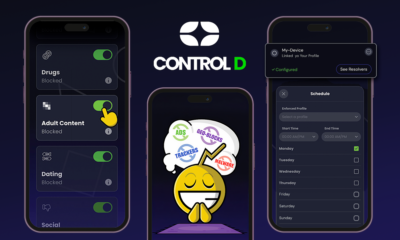TECHNOLOGY
Could GPT Models Become AGIs ?
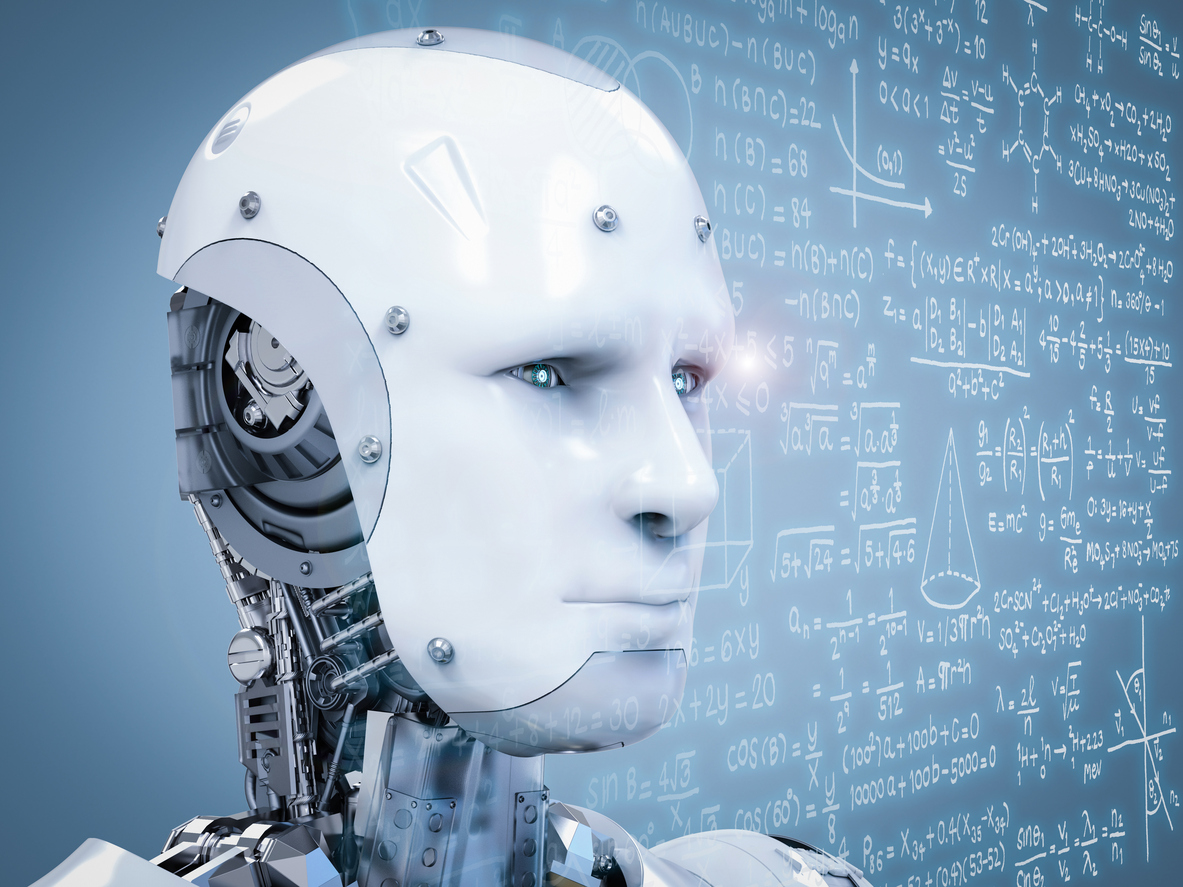
Picture this : a world where AI is not just a “chatbot” you interact with, but an entity that is responsible for decision making, scientific research and even guiding humanity forward.
Welcome to the world of AGIs, Artificial General Intelligence, which refers to AI systems as smart as humans, or greater. The quest for AGI has been a long-standing goal of the AI community, and recent advances in generative models have led to an increasing interest in their potential for achieving AGI.
Generative Models
A generative model is a type of machine learning model that is able to generate data samples, based on the large volumes of data that it is trained on (mostly text but now increasing images as well). They can learn the patterns and structures of language from a large corpus of text and then generate new text that is coherent and follows the same patterns.
The breakthrough here was to use “Transformers” – a type of neural network introduced in 2017. (see Appendix)
Now, more interestingly ……I asked GPT whether a Generative Model could generate something that was never in its training data ( important as we move to AGIs ). Here was its response:
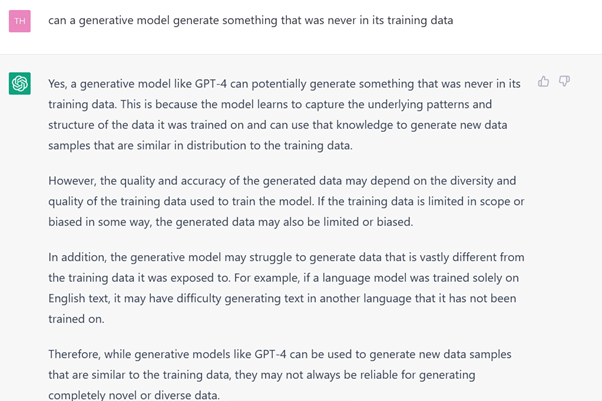
The answer is that, by identifying patterns and data structure, it may be able to, but will struggle to generate anything vastly different from the training data, and nothing “completely novel”. This is where we are currently.
A Mirror Into Your Civilization……
If I had to describe GPT in an exciting way :
Currently, Generative Models are a mirror of your civilization at a point in time, an automated and efficient record and reflection of everything you have done ( once trained on everything )
Given that humans have to generate science, art and culture over many years, and then train the models on the entirety of this, there is a huge dependency – for these Generative models to have any value, the content on which the model is trained needs to be created first.
These models may seem “smarter” than a human, but that is because they can access information generated by human culture and civilization instantly, whereas the humans, whose creativity came up with everything in the first place, cannot…..
The Two Planets Example
To further illustrate, I have come up with the “two planets” example.

Licensed by Creative Commons
In this scenario, imagine a duplicate civilization that has evolved to the same level as the Earth-Human civilization, say on Proxima Centauri. They would potentially have similar cultural achievements, and the same level of technology, although their language, appearance, etc could be different. At the same time as Earth, they develop Generative models and their version of GPT4.
If we queried the Earth GPT4 model about anything on Proxima Centauri, it would know nothing…..
Of course, the reciprocal would apply as well. Even a more advanced model, a GPT 5 or 6, would have the same limitations, as it was not trained on any data from that planet. Would you still consider it “intelligence” ?
How useful would GPT be in this scenario? Well, if the aliens came here, they could use the Earth GPT4 to learn all about our planet, culture and achievements, assuming they quickly learned one of our languages that the GPT model is also familiar with. However, what was once being spoken of as an “AGI” may not be considered as such in this example.
What would be truly impressive is if the Earth GPT4 could understand images or pass an IQ test from the hypothetical Proxima Centauri civilization….
Innate Intelligence
It is still amazing to me that GPT4 has an understanding of patterns, relationships in images, and the ability to pass a simple IQ test. Yes, it was trained by its creators to do this, based on data of mankind’s history, but once trained it has this ability.

From the GPT4 Whitepaper
This brings us to the definition of Intelligence itself, and the concept of innate intelligence.
“Every living being has some level of innate intelligence”
While factors such as education, socioeconomic status, and cultural experiences can impact cognitive development and, in turn, influence IQ test performance in humans, these are not the only factors that influence intelligence. Genetics, neurological factors, and individual differences in learning capability also play a role. Therefore, there is an innate intelligence in every living being that plays a large part in the resulting visible intelligence demonstrated in the real world.
How Do We Create an Artificial Intelligence with Some Level of Innate Intelligence ?
Remember, if a human baby grows up in a culture different to his/her parents, learning a different language, the child still manages to learn quickly.
Consider this – if we go back to the Two Planets example, and we are confident that while the Earth GPT4, 5 or 6 will have no knowledge of culture, language, events etc from another civilization, but that it WILL manage to :
· Perform mathematical calculations that are constant in the universe
· Understand basic patterns that are constant in the universe
· Learn the basic structures of language that may be common in the universe
· Thus, ….have the ability to potentially learn from ANOTHER civilization and their data
We then approach something very exciting…… we could then argue that in creating these models which, admittedly had to be trained on all our data to start with, we are taking the first steps into creating something with a small amount of innate intelligence. And each subsequent model would then build on the previous in terms of capability, until….well, would iteration 7 or 8 be an AGI ?
Are they AGIs ?
At this point we need to be clear on what our definition of an AGI is, as we are finally moving in the direction closer to creating one. I believe that our definition has become muddied.
Does an AGI and the Singularity simply refer to any intelligence smarter than humans ?
If we go back to the 1993 definition of the Singularity, as per the book “The Coming Technological Singularity” by Vernor Vinge, he spoke of “computers with super-human intelligence”. I could argue that GPT4 already is smarter than any human in terms of recalling knowledge, although it would be less capable in creativity, understanding and emotional intelligence.
He also talks about human civilization evolving to merge with this super intelligence. This hasn’t happened but brain interfaces have been built already. A brain interface into Chat GPT4 that would allow a human to call up all our civilizations knowledge instantly, turning him/her into a “super human”, is actually possible with today’s technology. It could be argued then that we have met the criterion already for the singularity by the 1993 definition……
The Singularity
If we move to futurist Ray Kurzweils definition of the Singularity, he spoke of “…when technological progress will accelerate so rapidly that it will lead to profound changes in human civilization…”.
Here, the year 2023 will certainly go down as the start of this change. The year 2023, due to the emergence of GPT3 and then GPT4, is a watershed year in technological history, like the launch of the PC or the internet.
Already there are conversations that I can only have with GPT4 that I cannot have with anyone else. The reason is that the humans around my may now be knowledgeable on particular topics, so I turn to GPT4. I sometimes do try to argue with it and present my opinion, and it responds with a counter argument.
By our previous definition of what an AGI could be, it can be argued that we have already achieved it or are very close with GPT4.
We are now certainly on the road to AGI, but we now have to clearly define a roadmap for it. This isn’t binary anymore, as in something is either an AGI or not. More importantly, the fear mongering around AGIs will certainly not apply to all levels of AGI, once we clearly define these levels.
This is particularly important, as recently people such as Elon Musk have publicly called for a “pause” in the development of AGIs as they could be dangerous. While this is correct, this will also rob humanity of the great benefits that AIs will bring to society.
Surely if we create a roadmap for AGIs and identify which level would be dangerous and which will not, we could then proceed with the early levels while using more caution on the more advanced levels ?
The AGI Roadmap
Below is a potential roadmap for AGIs with clearly defined stages.
Level 1: Intelligent Machines – Intelligent machines can perform specific tasks at human-level or better, such as playing chess or diagnosing diseases. They can quickly access the total corpus of humanity’s scientific and cultural achievements and answer questions. Are we here already ?
Level 2: Adaptive Minds – AGIs that can learn and adapt to new situations, improving their performance over time through experience and feedback. These would be similar to GPT4 but continue learning quickly post training.
Level 3: Creative Geniuses – AGIs capable of generating original and valuable ideas, whether in science, art, or business. These AGIs build on the scientific and cultural achievements of humans. They start giving us different perspectives on science and the universe.
Level 4: Empathic Companions – AGIs that can understand and respond to human emotions and needs, becoming trusted companions and helpers in daily life. This is the start of “emotion” in these intelligent models, however by this time they may be more than just models but start replicating the brain in electronic form.
Level 5: Conscious Thinkers – AGIs that have subjective experiences, a sense of self, and the ability to reason about their own thoughts and feelings. This is where AGIs could get really unpredictable and potentially dangerous.
Level 6: Universal Minds – AGIs that vastly surpass human intelligence in every aspect, with capabilities that we cannot fully define yet with our limited knowledge. These AGIs are what I imagined years ago, AGIs that could improve on our civilizations limitations, and derive the most efficient and advanced designs for just about anything based on the base principles of physics ( ie. Operating at the highest level of knowledge in the universe).
As you can see, levels 1-3 may not pose much of a physical threat to humanity, while offering numerous benefits to society, therefore we could make an argument for continuing to develop this capability.
Levels 4-6 could pose a significant threat to humanity. It is my view that any work on a level 4-6 AGI should be performed on a space station on the Moon base, to limit potential destruction on Earth. It is debatable whether human civilization would be able to create a Level 6 AGI, even after 1000 years…
Universal Minds
Over the last few decades, I have been fascinated with the concept of an Advanced AGI, once that is more advanced than humans and that could thus rapidly expand our technological capability if we utilize it properly.
Here is an old blog post on my Blog from 2007 where I was speculating on the Singularity being near, after following people like Kurzweil.
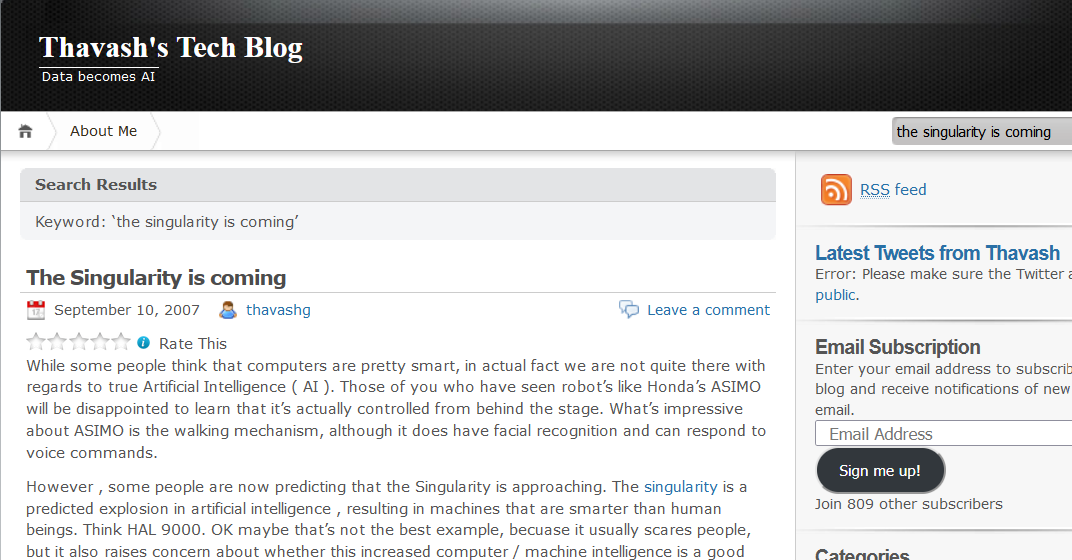
Copyright: My Blog
What I always imagined was a “super intelligence” that understood the universe from basic principles much better than we did, even if it was something we created. Imagine an intelligence that, once it gets to a certain point, facilitates its own growth exponentially. It would perform its own research and learning.
It would be logical that such intelligence plays a role in the research function of humanity going forward.
It could take the knowledge given to it and develop scientific theory far more effectively than humans. Already today, for example, we see a lot of data used in Reinforcement Learning being simulated and generated by AI itself. And if the total data we have is limiting, we could then ask it to design better data collection tools for us, ie. Better telescopes, spacecraft, and quantum devices.
A simple example that I would use would be the computing infrastructure that we use, on which everything else is built.
Most computers today use what’s known as the “Von Neumann” architecture, which is shown below. The main drawback of this architecture is that data has to be constantly moved between CPU and memory, which causes latency.
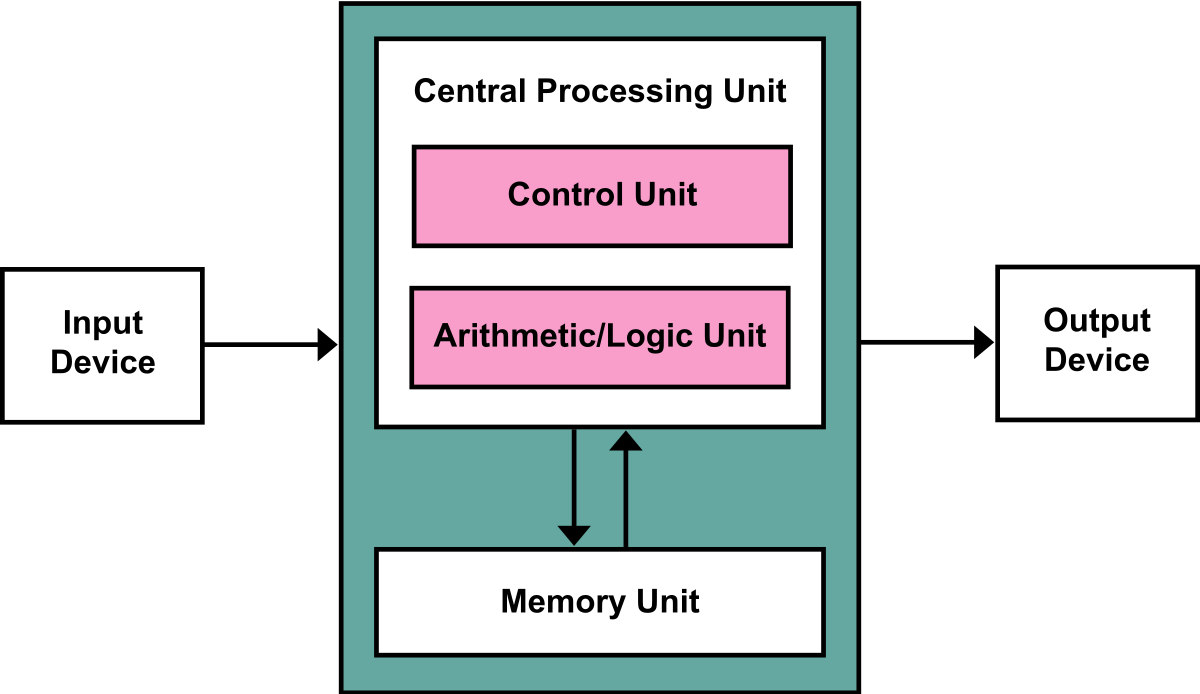
On top of this we typically use the x86 CPU, then Operating systems like Windows or Linux, then applications written in programming languages like C++.
Imagine if we could engineer an optimal, efficient computing architecture, from base principles, with orders of magnitude improvements at base architecture level, CPU level, OS level and application software level. This would be a difficult task for humans to undertake today, not just in terms of the actual technical design, but also in building it, and to collaborate on the next layer above, and to adopt the technology.
With a “super-intelligent” Universal AI, it would have the power to generate every layer at once.
It would also give us design schematics for the factories to build the new components, that too in the quickest and efficient way.
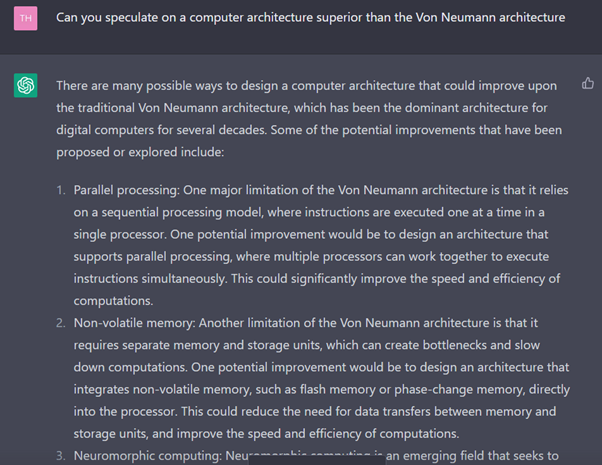
Now while all this seems like convenient fantasy, I have used the above example to illustrate the great strides that a “Universal Mind” could help humanity make.
Another example would be to ask it to calculate how best and efficiently to “solve the world hunger problem” or “solve the climate problem”.
When you consider the above, it does seem like the benefits outweigh the problems, although the one problem that has always been brought up is that a Universal Mind may decide to destroy humanity. Hence I say, if we’re going to try to build it, take the necessary safeguards, over and above the Responsible AI safeguards that we have today, and consider building the AGI off world, say on a space station or moon base, with the ability to cut networking and power if needed.
Summary
Hold on to your seats ! …..
Some GPT models have already shown an impressive ability to pass IQ tests and learn basic mathematics, hinting at the potential for developing a level of intelligence that goes beyond simple text generation. Now that we have an example of a roadmap for AGIs ( above ), we can certainly see how GPT is the start of the early phases in this roadmap, although more technical breakthroughs will be needed to eventually get to the later stages.
So buckle up and get ready – We don’t know where the end of this road is and where it will take us, but with GPT models now mainstream, we now know that as of 2023 we are at least on the road itself, travelling forward.
Appendix
Below is a great video that I found explaining what Transformers are:
TECHNOLOGY
Next-gen chips, Amazon Q, and speedy S3

AWS re:Invent, which has been taking place from November 27 and runs to December 1, has had its usual plethora of announcements: a total of 21 at time of print.
Perhaps not surprisingly, given the huge potential impact of generative AI – ChatGPT officially turns one year old today – a lot of focus has been on the AI side for AWS’ announcements, including a major partnership inked with NVIDIA across infrastructure, software, and services.
Yet there has been plenty more announced at the Las Vegas jamboree besides. Here, CloudTech rounds up the best of the rest:
Next-generation chips
This was the other major AI-focused announcement at re:Invent: the launch of two new chips, AWS Graviton4 and AWS Trainium2, for training and running AI and machine learning (ML) models, among other customer workloads. Graviton4 shapes up against its predecessor with 30% better compute performance, 50% more cores and 75% more memory bandwidth, while Trainium2 delivers up to four times faster training than before and will be able to be deployed in EC2 UltraClusters of up to 100,000 chips.
The EC2 UltraClusters are designed to ‘deliver the highest performance, most energy efficient AI model training infrastructure in the cloud’, as AWS puts it. With it, customers will be able to train large language models in ‘a fraction of the time’, as well as double energy efficiency.
As ever, AWS offers customers who are already utilising these tools. Databricks, Epic and SAP are among the companies cited as using the new AWS-designed chips.
Zero-ETL integrations
AWS announced new Amazon Aurora PostgreSQL, Amazon DynamoDB, and Amazon Relational Database Services (Amazon RDS) for MySQL integrations with Amazon Redshift, AWS’ cloud data warehouse. The zero-ETL integrations – eliminating the need to build ETL (extract, transform, load) data pipelines – make it easier to connect and analyse transactional data across various relational and non-relational databases in Amazon Redshift.
A simple example of how zero-ETL functions can be seen is in a hypothetical company which stores transactional data – time of transaction, items bought, where the transaction occurred – in a relational database, but use another analytics tool to analyse data in a non-relational database. To connect it all up, companies would previously have to construct ETL data pipelines which are a time and money sink.
The latest integrations “build on AWS’s zero-ETL foundation… so customers can quickly and easily connect all of their data, no matter where it lives,” the company said.
Amazon S3 Express One Zone
AWS announced the general availability of Amazon S3 Express One Zone, a new storage class purpose-built for customers’ most frequently-accessed data. Data access speed is up to 10 times faster and request costs up to 50% lower than standard S3. Companies can also opt to collocate their Amazon S3 Express One Zone data in the same availability zone as their compute resources.
Companies and partners who are using Amazon S3 Express One Zone include ChaosSearch, Cloudera, and Pinterest.
Amazon Q
A new product, and an interesting pivot, again with generative AI at its core. Amazon Q was announced as a ‘new type of generative AI-powered assistant’ which can be tailored to a customer’s business. “Customers can get fast, relevant answers to pressing questions, generate content, and take actions – all informed by a customer’s information repositories, code, and enterprise systems,” AWS added. The service also can assist companies building on AWS, as well as companies using AWS applications for business intelligence, contact centres, and supply chain management.
Customers cited as early adopters include Accenture, BMW and Wunderkind.
Want to learn more about cybersecurity and the cloud from industry leaders? Check out Cyber Security & Cloud Expo taking place in Amsterdam, California, and London. Explore other upcoming enterprise technology events and webinars powered by TechForge here.
TECHNOLOGY
HCLTech and Cisco create collaborative hybrid workplaces

Digital comms specialist Cisco and global tech firm HCLTech have teamed up to launch Meeting-Rooms-as-a-Service (MRaaS).
Available on a subscription model, this solution modernises legacy meeting rooms and enables users to join meetings from any meeting solution provider using Webex devices.
The MRaaS solution helps enterprises simplify the design, implementation and maintenance of integrated meeting rooms, enabling seamless collaboration for their globally distributed hybrid workforces.
Rakshit Ghura, senior VP and Global head of digital workplace services, HCLTech, said: “MRaaS combines our consulting and managed services expertise with Cisco’s proficiency in Webex devices to change the way employees conceptualise, organise and interact in a collaborative environment for a modern hybrid work model.
“The common vision of our partnership is to elevate the collaboration experience at work and drive productivity through modern meeting rooms.”
Alexandra Zagury, VP of partner managed and as-a-Service Sales at Cisco, said: “Our partnership with HCLTech helps our clients transform their offices through cost-effective managed services that support the ongoing evolution of workspaces.
“As we reimagine the modern office, we are making it easier to support collaboration and productivity among workers, whether they are in the office or elsewhere.”
Cisco’s Webex collaboration devices harness the power of artificial intelligence to offer intuitive, seamless collaboration experiences, enabling meeting rooms with smart features such as meeting zones, intelligent people framing, optimised attendee audio and background noise removal, among others.
Want to learn more about cybersecurity and the cloud from industry leaders? Check out Cyber Security & Cloud Expo taking place in Amsterdam, California, and London. Explore other upcoming enterprise technology events and webinars powered by TechForge here.
TECHNOLOGY
Canonical releases low-touch private cloud MicroCloud

Canonical has announced the general availability of MicroCloud, a low-touch, open source cloud solution. MicroCloud is part of Canonical’s growing cloud infrastructure portfolio.
It is purpose-built for scalable clusters and edge deployments for all types of enterprises. It is designed with simplicity, security and automation in mind, minimising the time and effort to both deploy and maintain it. Conveniently, enterprise support for MicroCloud is offered as part of Canonical’s Ubuntu Pro subscription, with several support tiers available, and priced per node.
MicroClouds are optimised for repeatable and reliable remote deployments. A single command initiates the orchestration and clustering of various components with minimal involvement by the user, resulting in a fully functional cloud within minutes. This simplified deployment process significantly reduces the barrier to entry, putting a production-grade cloud at everyone’s fingertips.
Juan Manuel Ventura, head of architectures & technologies at Spindox, said: “Cloud computing is not only about technology, it’s the beating heart of any modern industrial transformation, driving agility and innovation. Our mission is to provide our customers with the most effective ways to innovate and bring value; having a complexity-free cloud infrastructure is one important piece of that puzzle. With MicroCloud, the focus shifts away from struggling with cloud operations to solving real business challenges” says
In addition to seamless deployment, MicroCloud prioritises security and ease of maintenance. All MicroCloud components are built with strict confinement for increased security, with over-the-air transactional updates that preserve data and roll back on errors automatically. Upgrades to newer versions are handled automatically and without downtime, with the mechanisms to hold or schedule them as needed.
With this approach, MicroCloud caters to both on-premise clouds but also edge deployments at remote locations, allowing organisations to use the same infrastructure primitives and services wherever they are needed. It is suitable for business-in-branch office locations or industrial use inside a factory, as well as distributed locations where the focus is on replicability and unattended operations.
Cedric Gegout, VP of product at Canonical, said: “As data becomes more distributed, the infrastructure has to follow. Cloud computing is now distributed, spanning across data centres, far and near edge computing appliances. MicroCloud is our answer to that.
“By packaging known infrastructure primitives in a portable and unattended way, we are delivering a simpler, more prescriptive cloud experience that makes zero-ops a reality for many Industries.“
MicroCloud’s lightweight architecture makes it usable on both commodity and high-end hardware, with several ways to further reduce its footprint depending on your workload needs. In addition to the standard Ubuntu Server or Desktop, MicroClouds can be run on Ubuntu Core – a lightweight OS optimised for the edge. With Ubuntu Core, MicroClouds are a perfect solution for far-edge locations with limited computing capabilities. Users can choose to run their workloads using Kubernetes or via system containers. System containers based on LXD behave similarly to traditional VMs but consume fewer resources while providing bare-metal performance.
Coupled with Canonical’s Ubuntu Pro + Support subscription, MicroCloud users can benefit from an enterprise-grade open source cloud solution that is fully supported and with better economics. An Ubuntu Pro subscription offers security maintenance for the broadest collection of open-source software available from a single vendor today. It covers over 30k packages with a consistent security maintenance commitment, and additional features such as kernel livepatch, systems management at scale, certified compliance and hardening profiles enabling easy adoption for enterprises. With per-node pricing and no hidden fees, customers can rest assured that their environment is secure and supported without the expensive price tag typically associated with cloud solutions.
Want to learn more about cybersecurity and the cloud from industry leaders? Check out Cyber Security & Cloud Expo taking place in Amsterdam, California, and London. Explore other upcoming enterprise technology events and webinars powered by TechForge here.
-

 MARKETING6 days ago
MARKETING6 days agoEffective Communication in Business as a Crisis Management Strategy
-

 SEARCHENGINES7 days ago
SEARCHENGINES7 days agoGoogle Won’t Change The 301 Signals For Ranking & SEO
-

 SEO6 days ago
SEO6 days agobrightonSEO Live Blog
-

 PPC7 days ago
PPC7 days ago9 Ecommerce Trends to Boost Your Business in 2024
-

 SEO5 days ago
SEO5 days agoGoogle March 2024 Core Update Officially Completed A Week Ago
-

 SEO7 days ago
SEO7 days agoHow To Write ChatGPT Prompts To Get The Best Results
-

 WORDPRESS5 days ago
WORDPRESS5 days ago9 Best WooCommerce Multi Vendor Plugins (Compared)
-
SEARCHENGINES6 days ago
Daily Search Forum Recap: April 25, 2024





